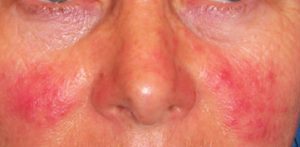In other occasions we have talked about rosacea, a relatively common skin disease that causes redness of the skin on the cheeks and nose (erythematotelangiectatic rosacea), which may be associated with pimples in the same areas (papulopustular rosacea). It is a chronic disease that we do not know how to cure completely, but fortunately new medications have recently been marketed in Spain that help to significantly reduce its symptoms. We talked about brominidine (to reduce redness) months ago, and this time it is the turn of topical ivermectin, which was launched a few weeks ago. Topical ivermectin is indicated for the treatment of papulopustular rosacea.

What is ivermectin
Ivermectin is a chemical compound derived from avermectin, which is produced by the bacterium Streptomyces avermitilis. Precisely the 2015 Nobel Prize in Medicine has been awarded to William C. Campbell and Satoshi Ōmura for their discovery.
Ivermectin is an antiparasitic that has won the 2015 Nobel Prize.
SIvermectin is an antiparasitic compound that has been shown to cure diseases such as river blindness (onchocerciasis) and elephantiasis (filariasis), which have a significant impact in tropical developing countries. Ivermectin also has anti-inflammatory properties.
Why is ivermectin effective for rosacea?

A small mite that normally lives in the follicles of our skin (called Demodex folliculorum) is thought to be involved in the development of rosacea, as it has been found to be present in greater numbers in people who suffer from rosacea than in those who do not. Although the exact role of Demodex in the development of the disease is not known, since ivermectin is an antiparasitic compound, it is possible that by using it we are destroying the Demodex on the skin and this leads to an improvement in the pimples.
Ivermectin is believed to work by destroying Demodex living in skin follicles.
However, in addition to its antiparasitic properties, ivermectin also has anti-inflammatory properties, and it is not entirely clear which of these two functions is more important in the treatment of rosacea.
How is ivermectin for rosacea applied?

Before starting treatment, it is important to have a proper medical diagnosis. I recommend that you be evaluated by a dermatologist for this purpose. In my experience, people are sometimes diagnosed with rosacea when they do not have rosacea, and in such cases, it would not be wise to use ivermectin.
Ivermectin 1% cream is applied to the pimples once a day. Improvement may be seen after the second week of use. Skin irritation may occur in 1% of cases.
Not recommended if you are pregnant or breastfeeding. There is currently no data on the effects on children.
What is the bottom line?
This is undoubtedly a promising treatment for papulopustular rosacea, i.e. people whose rosacea is associated with the appearance of pimples (it is not indicated for skin redness). Given the significant impact that rosacea can have on a person’s daily life, and often on their self-esteem, it is great to see new treatments being developed for rosacea.
Ivermectin cream is a promising treatment for rosacea pimples, although it is more expensive.
Scientific work has been done comparing ivermectin with topical azelaic acid and metronidazole, both drugs commonly used for rosacea. They have found ivermectin to be more effective. Perhaps the two biggest drawbacks at the moment are that its cost is higher than other treatments and that in Spain it is not covered by Social Security System. We will see what the experience tells us…
Have you tried ivermectin for rosacea?
